Finding the best backpacking tent is important to ensure you are not carrying something too heavy, bulky and annoying on your adventures.
Sometimes, spending the night outdoors and embracing nature can be one of life’s simplest pleasures. Holidays that involve a long hike through unfamiliar terrain before pitching a tent are hugely popular in all seasons with sporty types, and for good reason – it’s not often that your vacation manages to encompass exercise, adventure and possibly even an awakening of the mind and spirit.
Of course, nothing can sour this sense of self gratification, faster than having to haul an oversized and uncomfortable shelter with you on your endeavor.
You wouldn’t haul a wheeled suitcase behind you whilst negotiating rugged terrain, so why would you use a tent that cannot be rolled up and placed upon your back with the rest of your supplies?
This guide will talk you through what to look for in a backpacking tent, and recommend five of the finest purchases of this ilk that can be easily obtained online.
Top 5 Tents for Backpacking
Winterial 2 Person Tent
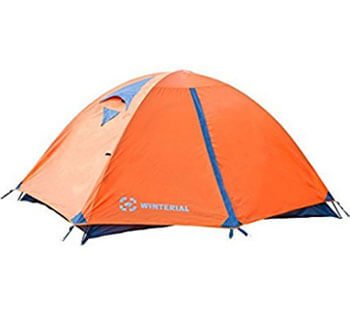
A lightweight two-person tent, the Winterial weighs in at just over 5lbs, making it the ideal solution for any backpacker looking to travel light.
Incorporating a carry bag, two poles and four stakes, alongside two doors., The Winterial is extremely quick to set up, low in cost, and provides sufficient warmth to shelter a camper on a mild night outdoors.
PROS – A perfect starter tent, and ideal for scouts or solo travelers in particular, the Winterial is cheap and cheerful, perfectly light enough to carry on your back as you hike, and the two doors ensure that if you’re sharing there’s no need to clamber all over each other to answer late night calls of nature.
CONS – Lightweight and low-cost tents are always popular but the trade-off is that they tend not to be as hard wearing, and the Winterial is no exception. The tent markets itself as three-season, but the fiberglass poles may not stand up to a particular battering from high fall winds, and there may be some intrusion from heavy rain.
TETON Sports Mountain Ultra Tent
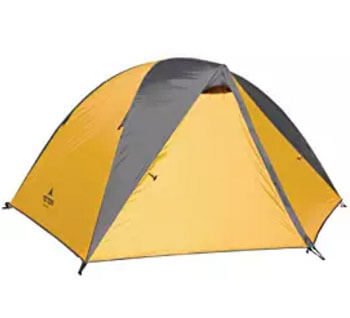
Available in one-, two-, three- or four-person sizes, most of which are perfectly light for carrying alongside a backpack, the TETON Sports Mountain Ultra is one of the most flexible and highly regarded tents on the market today.
This tent is built to last, with TETON so confident in the performance that they offer a lifetime guarantee, this tent weights in ranges from just 4.5lbs to 9.5lbs, and offers plenty of interior height.
As a four-season shelter, it should also ensure that you remain protected from the elements no matter when you decide to go camping.
PROS – The lifetime guarantee offered by the manufacturer is reason enough to look into this particular tent, with such a promise not being made lightly.
The Sports Mountain Ultra stands up against strong and fierce winds, is extremely simple to assemble, comes bundled with a rain fly for additional protection, and providing enough space to settle into, if you feel the need wait until a particularly unpleasant storm.
CONS – The largest size obviously weighs in heavier than its smaller brethren, meaning that the four-person tent may not be quite perfect for backpackers, and if you’re serious about camping as a family you may be prepared to spend a little more on an even more firmly waterproof model. But of course, you can share the humping and carrying with other members of the party!
iCorer Waterproof Lightweight Tent
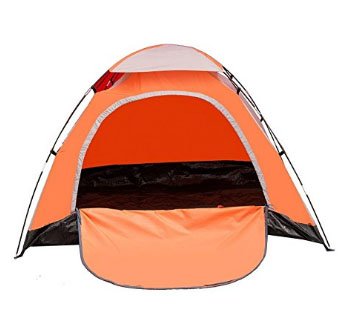
Comfortably housing up to three campers, this is a discount option that may compromise on price but not on quality.
Weighing less than 4lbs this is lighter than almost any other tent of the same size, and remains waterproof no matter what season you find yourself pitching in.
Incredibly simple to set up in just a few minutes and plenty spacious, you’ll struggle to find a more appropriate travel tent to take hiking or backpacking, while the bright orange color also makes it easy to spot among a number of other tents in a campsite.
At quite a low price, you really can’t go far wrong with this model if you’re an inexperienced camper.
PROS – Utterly waterproof, cheap as chips, easy to set up and lighter than a feather, there are a great many reasons why you should investigate the iCorer for all your camping needs, especially if you are new to the experience or travelling with small children. It’s quick and fun to erect, so get everyone involved.
CONS – Ventilation isn’t necessarily a strong point of the iCorer, with no windows or slots to speak of – this tent may get pretty toasty on a summer morning, especially with more than one body contributing heat to the air temperature.
This tent also doesn’t have the greatest height allowance, so if you stand at over six feet you may not as comfortable inside, especially if you’re sharing the space. Best to learn to crawl on your knees or bend in half!
Star Home Tents
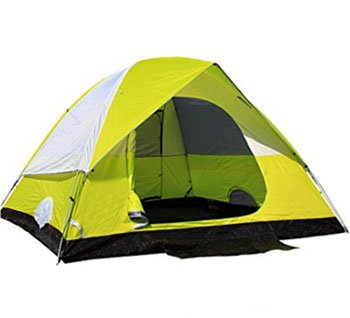
Star Home is a reputable brand that offers tents of multiple sizes that can play host up to two, four or six people.
Even at the largest size these tents remain lightweight and easily transportable as part of a backpack, and it remains fantastically waterproof all season long (although it stands up a little less well to wind).
Ventilation is also a strong point – particularly important if you are planning on squeezing a number of people into the tent – and the spacious floor area will allow for an air mattress of up to queen size. Great price, too.
PROS – It’s rare to find a multi-person tent that does not sacrifice a lightweight structure, but Star Home pull it off – even if you choose the six-person tent you won’t injure yourself carrying it between car and campsite. The tent also comes with pockets and great ventilation.
CONS – As mentioned earlier, while wholly waterproof, this particular tent does not hold up too well against gale force winds – utilizing it outside of the spring and summer months could be a little risky. It’s also not the simplest to set up, especially if you are attempting to do so alone.
Coleman Longs Peak 6-Person Fast Pitch Dome Tent
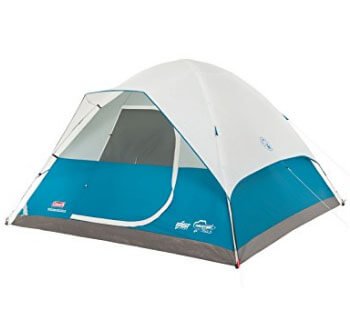
Standing six feet tall and providing enough floor space for a king size mattress, few tents can provide quite as much comfort and space as this model.
Waterproof no matter how much of a downpour you may be caught in, and offering plenty of ventilation (which will allow in just as much cold air as hot – this tent could get chilly during the cold seasons), this is a fine home from home for a small family who are looking to relocate to canvas-covered living for a few days, especially in the summer or other warm weather conditions.
The addition of a number of pockets are also helpful for multiple campers.
PROS – The name promises a fast pitch, and that’s exactly what this tent delivers – this is one of the quickest set-up times available for such a large tent.
Promising to house six people is always a dangerous promise for any tent to make, but the dimensions and domed shape of this tent certainly mean it’s comfortable for multiple sleepers. Great ventilation too, making it a fine summer choice.
CONS – Slightly more expensive than the other multi-person models on our list, and too heavy for some backpackers – 15lbs is no picnic to carry on your back single-handedly. The ventilation could also be deemed as a negative, as it means that this tent is not as warm as some competitors during the winter months.
Buyer’s Guide to Backpacking Tents
Choosing a backpacking tent can be a contradictory experience.
On the one hand, the whole idea of sleeping with just a canvas shelter between you and the stars is to embrace nature and disregard many of the trappings of modern day living, but on the other hand, your tent is your home for the duration of your holiday.
Tents may be different to a conventional dwelling, but ultimately, there are almost as many considerations in weighing up such a purchase as when buying a brick and mortar home.
Firstly, you should consider what type of tent you are looking for. There are five main categories to take into consideration.
Type Of Tent
Summer
As you can probably imagine, summer tents are designed for the hot, muggy months.
Typically thin enough to offer ventilation as the temperature rises and screen out unwelcome bug visitors, these tents are ideal for fair weather campers in warmer conditions, but they offer little protection when the weather changes.
Three-Season
Ideal for use from spring right through fall, a three-season tent will protect you from any weather bar the harshest of winters – the average three-season tent will offer no protection from snow.
This type of tent will again offer ventilation to avoid overheating but with thicker material than a summer/screen option, ensuring that you’ll stay dry and warm in a rainstorm.
Convertible
A convertible tent is an all-weather option that will cater for any need, typically comprising of a number of ‘windows’ that can be left open to accommodate heat, or closed to shut out adverse conditions.
Of course, there’s a trade-off to such flexibility in the form of weight – all the differing proponents of a convertible tent mean that there’s a whole lot to lug with you.
Mountaineering
If you’re plotting an expedition into the coldest and stormiest of territories, only a Mountaineering tent will do.
These canvas covers, also known as winter tents, can withstand all weathers and are usually bundled with all kinds of sturdy guy ropes and points in which to connect to the ground.
Like a convertible, though, you’ll have to put your back into carrying such a tent.
Tarp
At the other end of the spectrum, you have the feather light option of a tarp tent.
Probably only really ideal for experienced campers, a tarp tent does not come with the traditional structure of walls and a ‘floor’; a tarp is simply a solitary sheet that can be pinned firmly to the ground.
Done properly, however, and you’ll have a surprisingly potent shelter for a fraction of the weight.
Next, consider the shape of your tent. Again, many models come under one of three core designs.
Shape Of Your Tent
A-Frames
A-Frame tents are arguably the most popular and common design and are usually the lightest, making them perfect for backpackers. You will be sacrificing an element of wind protection and interior space, however, thanks to the sloping walls.
Domes
A domed tent may be more expensive and take up more floor space, but they are often taller than their A-Framed brethren and will allow for more room, in addition to providing better all-weather protection.
Pyramid
Also referred to as tee-pees, these tents are often light to carry and come with a central pole which allows plenty of headroom, hence the name; they take on the shape of a pyramid.
However, be aware that a pyramid tent usually has no floor, so prepare yourself for a damp night if the heavens open.
If you fancy camping ‘red-indian style’ this is the one for you!
Other Things To Consider
Once you have decided upon a type of tent, there are other things to consider before purchasing.
Dimensions
Start with the dimensions – you will be looking for a canvas that has enough floor space to allow you to stretch out, and is also tall enough to ideally stand up directly; it’s no fun attempting to change clothes from a permanently crouched position.
This will also tie into whether you opt for a one-, two- or three-person tent, or even larger. Bear in mind that a two-person tent, for example, will probably only comfortably fit one person if they stand at over six feet.
Entry Points
You can also look into entry points; most tents open via a zip at the front, but if multiple people are sharing the same shelter, it may be considered advantageous to have additional entry and exit points.
Storage
Storage is also a consideration – you won’t be able to carry a safe with you on your journey to keep your valuables within, so think about a tent that contains pouches or zips.
With this information in mind, above are five of the finest and best backpacking tents available to purchase. Take a look at the options and you will find the ideal solution for camping needs.
